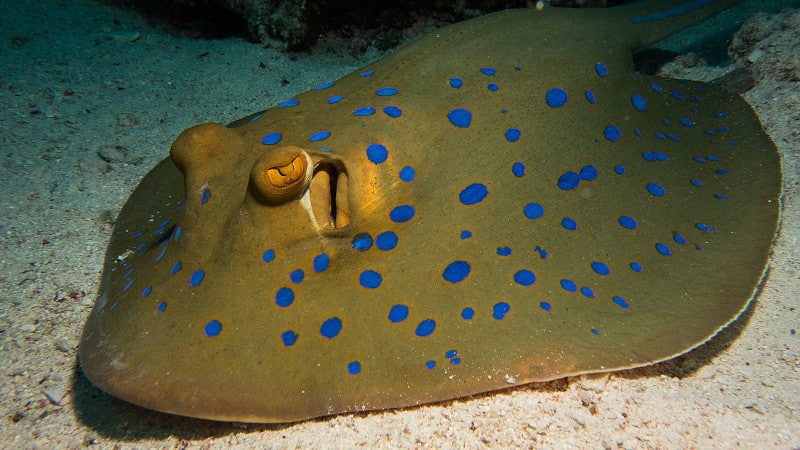
Bluespotted Ribbontail Ray Facts
- This marvel of Nature most frequently goes by the perfectly descriptive common name of the Bluespotted Ribbontail Ray for obvious reasons. Yet it has several other generally used monikers. These include fantail ray, bluespotted lagoon ray, and bluespotted ray.
- All of these, as well as several others, actually remain simpler than the technical name for the species. That’s somewhat unusual in itself. That’s true since the beautiful creature bears the comparatively short official name in the hallowed halls of science of the Taeniura lymma.
- This marvel of Nature owes that title to the Finnish naturalist, Peter Forsskål. This individual accomplished the first recorded recognition of it as a separate and distinct species. The researcher, an apprentice of Carl Linnaeus, achieved this noteworthy act in the year 1775.
- It’s generally quite timid in terms of its relations with humans. However, it’s fully capable of delivering a serious injury to humans via its venomous tail spines. Most commonly, though, when encounters in the wild do occur, the normally inoffensive animal flees harmlessly.
- For the moment, the Bluespotted Ribbontail Ray appears to be maintaining a population base that’s both sizeable and stable. That fortunate trend also seems to hold true throughout its known range. The IUCN presently lists the fish as Least Concern on its published Red List.
- Nevertheless, the beautiful fish does presently face some potential threats to its continued existence as a species. Most of these stem directly from human activities. Habitat degradation poses a serious danger at the moment. It also faces the effects of ongoing climate change.
Related Articles
Porcupine Ray
Bluespotted Ribbontail Ray Physical Description
The gorgeous Bluespotted Ribbontail Ray rarely fails to catch the eye of those who encounter it. The animal generally does so due to its appearance, more than sheer size. That’s because this marine wonder is a smaller than average variety of ray. Nature packed a lot of wonder in, though.
Like many of the fauna found around the world, this amazing creature displays a minor degree of sexual dimorphism. In the case of this species, that physiological trait manifests itself in terms or pure physical measurements. As a general rule, females grow slightly smaller than males.
Apart from that, individuals of both genders remain virtually indistinguishable to the untrained eye. The disk of mature adults reaches an average 14 in (35 cm) across. This also attains an average length measuring roughly 31 in (80 cm). A typical weight equals approximately 11 lb (5 kg).
In addition to the oval disk, the snout develops as relatively broad and angular. The eyes of the animal develop as relatively large and protruding. The pelvic fins of the impressive fish appear angular and somewhat narrow. Both jaws develop as lined with small but numerous teeth.
The tail of the visually stunning Bluespotted Ribbontail Ray also serves to make it easily distinguishable. This appendage usually reaches a length roughly equal to half again that of the body itself. It also generally possesses either one or two venomous, serrated spines behind the base.
But its the coloring of the impressive creature that usually receives the most attention. It’s also the source of the common name. The skin is smooth, with a background color that ranges from green to yellowish brown. Many rounded, neon-blue dots of various sizes cover most of the body.
- Kingdom: Animalia
- Phylum: Chordata
- Class: Chondrichthyes
- Order: Myliobatiformes
- Family: Dasyatidae
- Genus: Taeniura
- Species: T. lymma
Bluespotted Ribbontail Ray Distribution, Habitat, and Ecology
The stunning Bluespotted Ribbontail Ray evolved as indigenous to a region of the globe that’s somewhat unique in its nature. That’s true since that area is simultaneously relatively broad but limited. The wonder’s overall zone of habitation comprises most of the greater Indo-Pacific Region.
That intriguing territorial area begins in the waters of South Africa, in Africa. From there, though, it also extends through the Arabian Peninsula to Southeast Asia. In the Pacific Ocean, this wonder appears from the Philippines to northern Australia, and as far east as the Solomon Islands.
That’s the broader range for the creature. Within that greater area, however, its choice of habitat sharply reduces its area of coverage. That’s because it makes its home almost exclusively in areas close to the shore. The beautiful ray rarely appears at depths greater than 100 ft (30.5 m).
It’s also evolved as a primarily bottom-dwelling variety of ray. The intriguing fish most often frequents areas comprised of either sections of coral reef or nearby sandy flats. Some few individuals occasionally appear in regions formed of seagrass beds, tidal pools, and intertidal zones.
The Bluespotted Ribbontail Ray additionally developed as a mainly nocturnal species. Most observed specimens spend the great majority of the day hiding in caves, or under coral reefs, and even shipwrecks. It usually gathers in small groups at night, in shallow areas, to begin feeding.
It principally consumes various types of small molluscs, shrimps, crabs, and worms. These it deftly digs up from the ocean floor. The remarkable animal also feeds on numerous small fish species. In turn, its own predators mostly consist of bottlenose dolphins and hammerhead sharks.
Species Sharing Its Range
Check out our other articles on 5 Incredible Invertebrates of Japan, Heartleaf Foamflower, Sacred Valley, Bristlecone Hemlock, Alligator Snapping Turtle, June Bug, Tiger Shark, Maned Wolf
